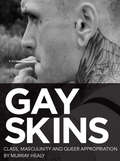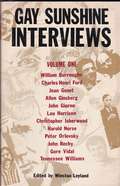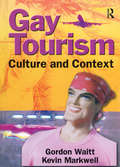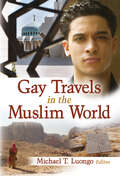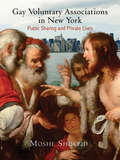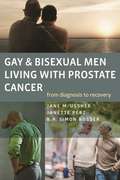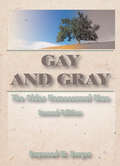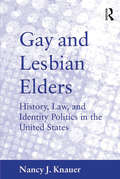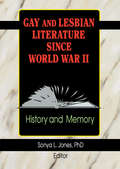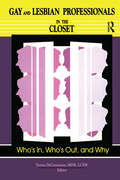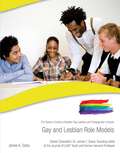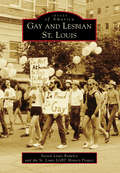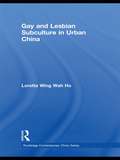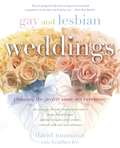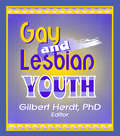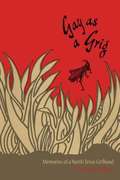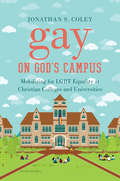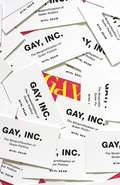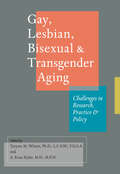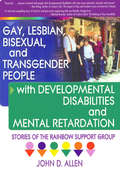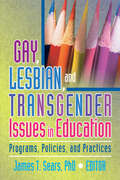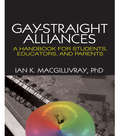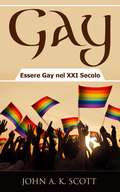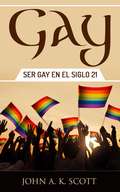- Table View
- List View
Gay Skins: Class, Masculinity and Queer Appropriation
by Murray HealySince their birth in the late 1960's as a working class subcultural response to what was seen as a feminised, bourgeois-hippy parent culture, the skinhead has since held a semi-mythological status amongst the UK's street tribes. But from the off, queer undercurrents inevitably ran through skinhead culture, as shaven heads, shiny DMs and tight Levis fed inevitably into fantasies and fetishes based around notions of ultra-masculinity. In this updated 1996 mini classic, Murray Healy looks into the myths and misapprehensions surrounding Gay Skins, exploring fascism, fetishism, class , sexuality and gender.
Gay Sunshine Interviews, Volume 1
by Winston LeylandIn-depth interviews with gay poets, novelists, playwrights and composers published originally in Gay Sunshine journal from 1974 to 1978. They provide seminal insights into the connections between sexuality and artistic creativity, as well as dramatic revelations on the personal and literary lives of the interviewees. Interviewed are William Burroughs, Charles Henri Ford, Jean Genet, Allen Ginsberg, John Giorno, Lou Harrison, Christopher Isherwood, Harold Norse, Peter Orlovsky, John Rechy, Gore Vidal, and Tennessee Williams.
Gay Tourism: Culture and Context
by Gordon Waitt Kevin MarkwellThe gay tourism industry-a progressive social force or a pull towards an oppressive status quo?The pink tourism dollar is now recognized as a highly profitable niche of the tourism market. Gay Tourism: Culture and Context critically investigates the emergence of a commercial gay tourism industry for male clients, the way it is organized, and how the tourism industry promotes cities, resorts, and nations as &’gay&’ destinations. This careful examination critically questions the social, political, and cultural implications regarding relationships between gay tourism, Western gay male culture, the erotic, sexual politics, and sexual diversity.Gay Tourism: Culture and Context begins by detailing how travel often enabled the expression of Western same-sex male desire in the nineteenth century and then charts the emergence of a Western gay tourism industry in the late twentieth century. A critical analysis is given of gay guidebooks and erotic videos that help to establish and maintain destinations as seemingly gay utopias, including Hawaii and the Greek island Mykonos. Carefull consideration as to debates about how the gay tourism industry operates in the context of questions regarding the globalization of sexuality, sexual citizenship and place-marketing of (homo)sexualised cities. The text includes an extensive bibliography plus several photographs, charts, and figures to clearly present concepts and ideas.Topics in Gay Tourism: Culture and Context include: the history of gay travel and tourism the effect of HIV/AIDS on gay tourist destinations gay travel writing sustaining same-sex fantasies about popular gay tourist destinations analysis of the socio-political ramifications of gay tourism the sexual politics of a heterosexual nation gay tourists as an "invading force" of corruption the economic rationale for the (homo)sexualized city the concept of "gay villages" the role of special events and festivals in gay tourism and many more!Gay Tourism: Culture and Context is enlightening reading for tourism policymakers, tourism planners, tourism managers, and teachers and students in the fields of tourism studies, gay studies, social and cultural geography, and sociology.
Gay Travels in the Muslim World
by Michael LuongoTravel beyond the fear and paranoia of 9-11 to experience Muslim cultureGay Travels in the Muslim World journeys where other gay travel books fear to tread-Muslim countries. This thought-provoking book tells both Muslim and non-Muslim gay men's stories of traveling in the Middle East during these difficult political times. The true, very personal tales reveal how gay men celebrate their lives and meetings with local men, including a gay soldier's story of his tour of duty in Iraq. Insightful and at times sexy, this intelligent book goes beyond 9-11 and the present political and cultural divides to illustrate the real experiences of gay men in trouble zones-in an effort to seek peace for all.After the collapse of the Twin Towers, fears about terrorism and Muslim culture went hand in hand. Gay Travels in the Muslim World enters the current war zones to bring real and very personal stories of gay men who live and travel in these dangerous areas. This book challenges readers' preconceptions and assumptions about both homosexuality and being Muslim, while showing the wide range of experiences-good and bad-about the regions as well as the differences in attitudes and beliefs. Excerpts from Gay Travels in the Muslim World:From "I Want Your Eyes" by David StevensMen by themselves are rare. I pass a handsome Omani man sitting on the Corniche wall with a cigarette between his long brown fingers. He wears his colourful cuma cap at a jaunty angle and his mustard-coloured dishdasha has risen up to reveal tantalizingly hairy calves. I note the carefully made holes in his ears-not in his ear lobes but deep inside the cartilages-a pre-Islamic custom still practiced on some male babies to ward off evil spirits. I decide it suits him.From "It All Began with Mamadou" by Jay DavidsonDrawing definitive conclusions about a society after living here for a little more than a year is not a wise, safe, or responsible action on my part. If a society's culture is a mosaic of thousands of little tiles, then I like to think that what I have been able to piece together has been a tableau in which certain aspects have become discernable, some are a little less clear, and others remain in a way that I will never see as whole and comprehensible.From "A Market and a Mosque" by Martin ForemanSylhet, Bangladesh: It's eight o'clock in the evening and Tarique and Paritosh are taking me out to look at the cruising spots. Until I flew in here this afternoon, all I knew of the provincial city and the surrounding area was that it was where most of the Bangladeshis in the UK come from-and since most of the Bangladeshis in the UK live in my home borough of Tower Hamlets, I feel a kind of affinity with the place. Whether or not Sylhet feels an affinity with me is a different matter.From "Work In Progress: Notes From A Continuing Journey of Manufacturing Dissent" by Parvez SharmaIn the construction of the image and life of the "queer" Muslim is also the awareness of the not so well known fact that a sexual revolution of immense proportions came to the earliest Muslims, some 1,300 years before the West had even thought about it. This promise of equal gender rights and, unlike in the Bible, the stress on sex as not just reproduction but also enjoyment within the confines of marriage has all but been lost in the rhetoric spewing from loudspeakers perched on Masjid's-or mosques-in Riyadh, Marrakech and Islamabad. The same Islam that has for centuries not only tolerated but also openly celebrated homosexuality is, today, used to justify a state-sanctioned pogrom against gay men in Egypt-America's "enlightened" friend in the Middle East.Gay Travels in the Muslim World is a refreshing, well written look a
Gay Voluntary Associations in New York: Public Sharing and Private Lives
by Moshe ShokeidGay Voluntary Associations in New York is a sensitive and insightful ethnography of social groups that have gathered around common interests in an urban LGBT population from the time of the AIDS crisis to the present. Anthropologist Moshe Shokeid examines the social discourse of sex, love, friendship, and spiritual life in which these communities are passionately engaged.<P> Drawn from long-term anthropological research in New York City, Gay Voluntary Associations in New York uses participant observation to explore such diverse social associations and religious organizations as seniors groups, interracials, bisexuals, sexual compulsives, gay bears, and Catholic, Protestant, and Jewish gay congregations. As an outside observer--neither gay nor American-born--Shokeid examines the social discourse within these voluntary associations from a critical vantage point. In addition to the personal information and intimate expressions of empathy freely shared in the company of strangers at social gatherings, individual stories and experiences are woven into the narrative to illustrate the existential conditions and emotional template of gay life in the city. Shokeid's nuanced portrait of the affective relationships within these groups offers deeper comprehension of the social dynamics and emotional realities of gay urban communities in the United States.
Gay Warriors
by B. R. BurgIn Ancient Greece and Rome, in Crusader campaigns and pirate adventures, same-sex romances were a common and condoned part of military culture. From the Peloponnesian War to the Gulf War, from Achelleus to Lawrence of Arabia gays and lesbians have played a crucial but often hidden role in military campaigns. But recent debates over the legality of gay service in the military and the "don't ask, don't tell" policy have obscured this rich aspect of military history. Richard Burg has recovered important documents and assembled an anthology on these often invisible gay and lesbian warriors. Burg shows us that the Amazons of legend weren't just fictional. We learn about the richness and variety of their culture in documents from Plato, Seneca and Suetonius. From courts-martial proceedings we discover women warriors in seventeenth century England who passed as men in order to serve, and army officers whose underground culture fostered long-term romantic friendships. There are also sections on the American Civil War, World War I and II, the contemporary U.S. military as well as sailors and pirates. This anthology will forever change the way we think about "gays in the military."
Gay and Bisexual Men Living with Prostate Cancer: From Diagnosis to Recovery
by Jane Ussher Perz Janette Rosser B. R. SimonThis book provides an overview of research and practice dealing with the specific needs of gay and bisexual men living with prostate cancer, as well as the special psychosocial needs of their partners. The intention is twofold: to provide insight into the unique experiences and concerns of gay or bisexual men living with prostate cancer in order to inform and assist future research, clinical practice and supportive care, and policy; and to ensure that the needs of gay and bisexual men are recognized and advanced on the mainstream prostate cancer agenda. Featuring both cutting-edge research and powerful portraits of gay and bisexual men living with prostate cancer, this book will be indispensable for health care, oncology, and mental health practitioners who seek to address their specific experiences and challenges.
Gay and Gray: The Older Homosexual Man, Second Edition
by Raymond BergerIn the absence of accurate information, American culture has upheld a distorted view of what it means to be an older gay man. Gay and Gray is the first and only scholarly full-length treatment of older gay men in America today. It breaks the stereotype that older gay men are strange, lonely creatures and reveals that most older gay men are well-adjusted to their homosexuality and the aging process.This second edition contains four new chapters that present additional perspectives on the reality of gay aging. Dr. Minnigerode&’s study shows that older gay men do not perceive themselves as growing old faster than their heterosexual counterparts, and that forty is the age at which most gay men believe that the label “young” no longer applies--this finding led Berger and other researchers to define “older” gay men as those over forty. Pope and Schulz confirm Berger&’s finding that for most older gay men a continuation of sexual activity and sexual enjoyment is the norm. John Grube&’s paper on the interaction of older gay men with younger gay liberationists explores the cultural divide between today&’s older gay man and his younger counterpart, filling a gap left in the first edition. And a concluding chapter by Richard Friend on a theory of successful gay aging summarizes much of the current thinking about this topic. The true situation of the older homosexual male presented in Gay and Gray challenges preconceptions about what it means to be old and gay. It asserts that in most ways, older gay men are indistinguishable from other older people. Because the book portrays older gay men in a realistic and sympathetic light, it is therapeutic for the many gay men who have been burdened with society&’s negative and distorted views about them. These men may compare their own lives to those of the respondents described in the book. Gay and Gray offers younger gay men a rare glimpse into their futures and enlightens and comforts those who count older gay men among their family and friends. The conclusions drawn in the book will change people&’s perspectives and offer new ways of thinking for and about older gay men.Gay and Gray is filled with rich case histories and treats its subject with dignity and compassion. Topics of focus include: love relationships social and psychological adjustment gay community self-acceptance being ”in the closet” and ”coming out” as a gay person intergenerational attitudes popular stereotypesAs the first intensive interview and questionnaire study of gay men aged 40 and older in America, Gay and Gray examines the lives of these men in light of cultural stereotypes. Author Berger asks about the social lives of these men, their involvement in both the heterosexual and homosexual communities, their ”coming out” experiences, their attitudes about younger gays, their experiences in growing older, and their strategies for adapting to life&’s challenges. In the study, Berger reveals that, contrary to stereotypic views, most older gay men are well-integrated into social networks and lead active and generally satisfying lives. He found that few live alone; most scored as well as younger gays on measures of psychological adjustment, such as self-acceptance; many are open about their homosexuality with family, friends, and colleagues; and the most well-adjusted older gay men were integrated into a homosexual community, associated with younger gay men, and were unwilling to change their sexual orientation.
Gay and Lesbian Elders: History, Law, and Identity Politics in the United States
by Nancy J. KnauerThe approximately two million gay and lesbian elders in the United States are an underserved and understudied population. At a time when gay men and lesbians enjoy an unprecedented degree of social acceptance and legal protection, many elders face the daily challenges of aging isolated from family, detached from the larger gay and lesbian community, and ignored by mainstream aging initiatives. Drawing on materials from law, history, and social theory, this book integrates practical proposals for reform with larger issues of sexuality and identity. Beginning with a summary of existing demographic data and offering a historical overview of pre-Stonewall views of homosexuality, author Nancy J. Knauer goes on to address the invisibility of this community. She examines the multiple double binds central to their identity formation, including ageism among gays and lesbians and homophobia among seniors. Further, the book focuses on specific legal concerns such as estate planning, housing, discrimination, and financial insecurity, and how they impact this community uniquely. Integrating theory with practical questions of policy, and advancing a new understanding of the construction of sexuality and identity, this book advocates meaningful new reforms designed to ensure equity and dignity in aging regardless of sexual orientation.
Gay and Lesbian Literature Since World War II: History and Memory
by Sonya L JonesGay and Lesbian Literature Since World War II chronicles the multifaceted explosion of gay and lesbian writing that has taken place in the second half of the twentieth century. Encompassing a wide range of subject matter and a balance of gay and lesbian concerns, it includes work by established scholars as well as young theoreticians and archivists who have initiated new areas of investigation. The contributors’examinations of this rich literary period make it easy to view the half-century from 1948 to 1998 as the Queer Renaissance. Included in Gay and Lesbian Literature Since World War II are critical and social analyses of literary movements, novels, short fiction, periodicals, and poetry as well as a look at the challenges of establishing a repository for lesbian cultural history. Specific chapters in this groundbreaking work trace the development of gay poetry in America after World War II; examine how AIDS is represented in the first four Latino novels to deal with the subject matter; and chronicle the birth of lesbian-feminist publishing in the 1970s--showing how it created a flourishing gay literature in the 1980s and 1990s. Other chapters: outline the history of The Ladder from its initial publication in 1956 as the official vehicle of the Daughters of Bilitis to its final issue as a privately published literary magazine in 1972 examine Baldwin’s 1962 novel Another Country and discuss the complicated critical history of this work and its relation to Baldwin’s literary reputation--racial, sexual, and political factors are taken into account chart how Other Voices, Other Rooms, by Truman Capote, and The House of Breath, by William Goyen, reveal contradictory genderings of male homosexuality--suggesting an absence of a unified model of mid-twentieth-century male homosexuality argue that the 1976 novel Lover, by Bertha Harris, can be considered an exemplary novel within discussions of both postmodern fiction and lesbian theory. (The author calls for Harris to be added to the group of writers such as Wittig, Anzaldúa, Lorde, and Winterson, who are discussed within the context of a postmodern lesbian narrative.) examine the short fiction of Canadian lesbian novelist Jane Rule in an effort to shed light on lesbian creative practice in the homophobic climate of postwar North America argue for an understanding of Dale Peck’s novel Martin and John as an attempt to link two apparently different processes of import to contemporary male subjects through examination of the novel alongside selected passages from Nietzsche and Freud focus on the pragmatic issues of developing and maintaining accessible research venues from which to cultivate the study of racial and cultural diversity in lesbian lives Document the history of the Lesbian Herstory Archives, one of the first lesbian-specific collections in the world, from its birth in the early 1970s to the present.
Gay and Lesbian Professionals in the Closet: Who's In, Who's Out, and Why
by Teresa DecrescenzoThe closet takes its toll on its dwellers through their experiences of isolation, fear, paranoia, potentially increased internalized homophobia, and dissonance between role and identity; yet many people in the helping professions do not feel that it is desirable or even appropriate to disclose their sexual orientation to those receiving help. Gay and Lesbian Professionals in the Closet explores the different positions people take on this provocative issue, the arguments they use to support their positions, and why the issue may not be as clear-cut as it sometimes seems.While complex sociopsychological factors, cultural values and influences, and legal issues keep many gays, lesbians, and bisexuals in the closet, closeted practice may have its advantages. A closeted practitioner, whether case manager, counselor, psychotherapist, physician, or minister, can bring understanding and insight to practice with homosexual clients and their families, as well as lend substantial support to openly gay and lesbian helping professionals. Yet, as Gay and Lesbian Professionals in the Closet reveals, being closeted can compromise your integrity, as well as that of your clients, and the benefits of being out will likely outweigh those of being closeted. Being out will help readers: counteract stereotypes of gays and lesbians allow you to serve as a role model improve the quality of care offered by traditionally homophobic, or homo-ignorant, institutions and employees contribute to the establishment of affirming services and environments for both yourself and your clients stop segregating your sexual life from the rest of your life attain credibility with your clients not feed repression through silenceAs Gay and Lesbian Professionals in the Closet will show readers, it is always important to consider patients’needs and each work setting before coming out, but gay, lesbian, and bisexual social service providers should make decisions on a case-by-case basis, not avoid being out altogether. Being open in the workplace will remind caregivers, clients, and coworkers of the exemplary citizenship and service gays, lesbians, and bisexuals are capable of offering. Think again whether the closet carries protective cover from discrimination or tacit endorsement of homophobia.
Gay and Lesbian Role Models
by Jaime A. SebaWho do you look up to? Most people have a role model--someone who represents the person they want to be more like, who represents the characteristics they value. Athletes, celebrities, parents, politicians, religious leaders, and even friends can be role models. But many lesbian, gay, bisexual, and transgender (LGBT) people don't see people they relate to in their families, schools, or churches. That makes it so much more important to recognize the contributions of the gay and lesbian role models in the forefront of popular culture today. Learn more about some of the most prominent gay and lesbian role models, including late politician Harvey Milk, Bishop Eugene Robinson, Congressman Barney Frank, comedian Ellen DeGeneres, and former NBA player John Amaechi. By taking a stand as leaders in the community, they became role models to LGBT people of all ages around the world.
Gay and Lesbian St. Louis (Images of America)
by St. Louis LGBT History Project Steven Louis BrawleyIn the late 19th century, St. Louis--America's fourth-largest city--was a hub of robust commerce and risqué entertainment. It provided an oasis for those who lived "in the shadows." Since 1764, the Gateway to the West's LGBT community has experienced countless struggles and successes, including protests, arrests, murders, celebrations, and parades. St. Louis had its own version of Stonewall in October 1969 and is the hometown of icons such as Tennessee Williams and Josephine Baker. A colorful array of activists, drag queens, leather men, artists, academics, business leaders, and everyday folks have contributed to the rich fabric of the lesbian and gay community in St. Louis.
Gay and Lesbian Subculture in Urban China (Routledge Contemporary China Series)
by Loretta Wing HoThis book contributes to a critical understanding of how Chinese same-sex identity in urban China is variously imagined; how it is transformed; and how it presents its resistances as China continues to open up to global power relations. Equally important, the book will 1) sharpen knowledge of China’s recent socio-economic change and political agenda, 2) build a greater awareness of Chinese cultural, sexual and ethical values and 3) offer new perspectives on ‘Chineseness’ and Chinese same-sex identity. Uniquely, it explores the emergence of Chinese same-sex identity through understanding the everyday, lived same-sex experience, amid China’s opening up to cultural, sexual and economic globalisation. This understanding is based on a culturally sensitive framework which accommodates the diverse and sometimes paradoxical articulation of same-sex identity in urban China. It come sto the conclusion that same–sex identity in china is articulated in a paradoxical way: open and decentred, but at the same time, nationalist and conforming to state control. This book will be of interest to scholar and students in Chinese studies, Gender Studies, sexuality and cultural studies.
Gay and Lesbian Weddings: Planning the Perfect Same-Sex Ceremony
by David ToussaintComprehensive, fresh, and funny, Gay and Lesbian Weddings covers everything you need to know to plan the wedding of your dreams. Unlike other wedding planners, this one tackles the issues your heterosexual friends never had to consider. For instance, do you come out to Aunt Gloria before she receives the invitation and the shock of her life? Which father of the bride pays for a lesbian wedding? Who walks down the aisle first? Is it possible for members of the wedding party to be happy with what you force them to wear? (Okay, this is a universal problem.) Step-by-step and down-to-earth, Gay and Lesbian Weddings includes invaluable advice on* the changing laws regarding gay marriage in the United States and abroad; the differences among domestic partnerships, civil unions, and marriage* budget concerns: choosing your ideal wedding size and style* finding gay-friendly printers, photographers, gift registries, caterers, florists (actually, if you find a gay-hostile florist, we'd love to hear about it)* ethnic, theme, and destination weddings* keeping the honey in the honeymoon* sex--including how to keep the heat after the wedding night, as well as the facts on fidelity (can the two be linked?)Plus: a handy Wedding Countdown Calendar, website resources, and true stories from same-sex couples who've gotten hitched without a hitchGay and Lesbian Weddings gives you straight talk (so to speak) with equal parts information, flair, and fabulousness!From the Trade Paperback edition.
Gay and Lesbian Youth
by Gilbert HerdtHere is a pioneering volume that explores adolescent homosexuality around the world. Social scientists examine the personal experiences of gay and lesbian teenagers from culture to culture and address the problems and obstacles these young people face. The changing contexts, values, and goals of societies worldwide are affecting how these adolescents adapt to being homosexual, and this compelling book gives keen insight into how changes in the United States contrast with changes elsewhere. A unique and thorough description of the identities, situations, and relationships of homosexual teens in many societies, Gay and Lesbian Youth will help social scientists, health care professionals, counselors, gay teenagers, and their parents to better understand the similarities of the problems facing these youth, while recognizing the minor differences in their social and personal situations. How do the personal experiences of gay and lesbian teenagers vary from culture to culture? Here is the best, most complete description of the identities, situations, and relationships of homosexual teens in many societies. The changing contexts, values, and goals of societies worldwide are affecting how these adolescents adapt to being homosexual, and this compelling book gives keen insight into how changes in the United States contrast with changes elsewhere. Social scientists, health care professionals, counselors, gay teenagers, and their parents will better understand the similarities of the problems facing these youth, while recognizing the minor differences in their social and personal situations. These differences must be understood by interpreting the adaptations of gay and bisexual teenagers around the world.
Gay as a Grig: Memories of a North Texas Girlhood
by Ellen Bowie HollandEllen Bowie Holland grew up in a house at Weatherford, Texas, that had the "motherly look of a large and gallant hen hovering over too many chicks" and that was inhabited by a "lively, warm-hearted family. " This book is her record of the "whole world of little things which enriched young lives" in her small town. Blessed with a discerning and sympathetic eye, she had much happiness to remember and record, and she employs a charming combination of nostalgia and comedy as she brings to life again these bygone days. Her childhood experiences are illuminated by the wisdom of maturity, and the whole is infused with a deft humor, developed through her skilled use of fantasy and through her ability to laugh at the pretensions of the Victorian life she saw. Holland''s book also is memorable as a record of her unforgettable parents: "Mother was born on Columbus Day, and she and Columbus had a lot in common. She liked to discover things for herself and nothing pleased her more than to nicely finish off a job that she had been told could not be done" . . . "She wasn''t geared for solitary musing. Like a salmon at spawning time she liked to swim upstream against rushing waters and bash into boulders" . . . "Mother''s pattern of neatness reached out in all directions" . . . "Mother, sheathed like an armadillo" . . . "Father, silk-hatted, or swallow-tailed, distinguished almost beyond belief" . . . "I never heard him raise his voice or laugh aloud" . . . "Father was not witty but he had an absolutely delightful sense of nonsense. His humor came smoothly upon the scene" . . . Throughout the book the reader shares the author''s consciousness of the vast distance between her own childhood and that of the grandchildren to whom the book is dedicated--a distance created by rapid technological change. "From my window I look over an air-conditioned city and I see jets streaking across the sky and occasionally I hear one of them breaking the sound barrier" . . . "When I really want to awe myself I think about the fact that only one generation ago Mother saw friendly or marauding Indians roaming these same acres" . . . "Those of my age have come into a span of years where living conditions of all kinds have changed so abruptly, where obsolescence sets in so rapidly, that there is little in common between our infancy and our present. "Ellen Bowie Holland grew up in a house at Weatherford, Texas, that had the "motherly look of a large and gallant hen hovering over too many chicks" and that was inhabited by a "lively, warm-hearted family. " This book is her record of the "whole world of little things which enriched young lives" in her small town. Blessed with a discerning and sympathetic eye, she had much happiness to remember and record, and she employs a charming combination of nostalgia and comedy as she brings to life again these bygone days. Her childhood experiences are illuminated by the wisdom of maturity, and the whole is infused with a deft humor, developed through her skilled use of fantasy and through her ability to laugh at the pretensions of the Victorian life she saw. Holland''s book also is memorable as a record of her unforgettable parents: "Mother was born on Columbus Day, and she and Columbus had a lot in common. She liked to discover things for herself and nothing pleased her more than to nicely finish off a job that she had been told could not be done" . . . "She wasn''t geared for solitary musing. Like a salmon at spawning time she liked to swim upstream against rushing waters and bash into boulders" . . . "Mother''s pattern of neatness reached out in all directions" . . . "Mother, sheathed like an armadillo" . . . "Father, silk-hatted, or swallow-tailed, distinguished almost beyond belief" . . . "I never heard him raise his voice or laugh aloud" . . . "Father was not witty but he had an absolutely delightful sense of nonsense. His humor came smoothly upon the scene" . . . Throughout the book the reader shares the author''s consciousness of the vast distance bet...
Gay on God's Campus: Mobilizing for LGBT Equality at Christian Colleges and Universities
by Jonathan S. ColeyAlthough the LGBT movement has made rapid gains in the United States, LGBT people continue to face discrimination in faith communities. In this book, sociologist Jonathan S. Coley documents why and how student activists mobilize for greater inclusion at Christian colleges and universities. Drawing on interviews with student activists at a range of Christian institutions of higher learning, Coley shows that students, initially drawn to activism because of their own political, religious, or LGBT identities, are forming direct action groups that transform university policies, educational groups that open up campus dialogue, and solidarity groups that facilitate their members' personal growth. He also shows how these LGBT activists apply their skills and values after graduation in subsequent political campaigns, careers, and family lives, potentially serving as change agents in their faith communities for years to come. Coley's findings shed light on a new frontier of LGBT activism and challenge prevailing wisdom about the characteristics of activists, the purpose of activist groups, and ultimately the nature of activism itself. For more information about this project's research methodology and theoretical grounding, please visit http://jonathancoley.com/book
Gay, Inc.: The Nonprofitization of Queer Politics
by Myrl BeamA bold and provocative look at how the nonprofit sphere&’s expansion has helped—and hindered—the LGBT cause What if the very structure on which social movements rely, the nonprofit system, is reinforcing the inequalities activists seek to eliminate? That is the question at the heart of this bold reassessment of the system&’s massive expansion since the mid-1960s. Focusing on the LGBT movement, Myrl Beam argues that the conservative turn in queer movement politics, as exemplified by the shift toward marriage and legal equality, is due mostly to the movement&’s embrace of the nonprofit structure. Based on oral histories as well as archival research, and drawing on the author&’s own extensive activist work, Gay, Inc. presents four compelling case studies. Beam looks at how people at LGBT nonprofits in Minneapolis and Chicago grapple with the contradictions between radical queer social movements and their institutionalized iterations. Through interview subjects&’ incisive, funny, and heartbreaking commentaries, Beam exposes a complex world of committed people doing the best they can to effect change, and the flawed structures in which they participate, rail against, ignore, and make do. Providing a critical look at a social formation whose sanctified place in the national imagination has for too long gone unquestioned, Gay, Inc. marks a significant contribution to scholarship on sexuality, neoliberalism, and social movements.
Gay, Lesbian, Bisexual, and Transgender Aging: Challenges in Research, Practice, and Policy
by Tarynn M. WittenThe graying of the U.S. population draws increasing focus to historically unattended segments of society, including sexual and gender minorities. In this first comprehensive volume to address the challenges of aging in the gay, lesbian, bisexual, transgender, and intersex populations, this text presents what is currently known about aging GLBT individuals and what services are needed to support them. The editors first provide an introductory overview comparing caregiving in GLBT and normative aging communities. In chapters devoted to the issues of each alternative sexuality and gender identity community, top experts in the field discuss biomedical, psychological, social/sexual, spiritual, socioeconomic, and service topics related to that community's aging needs. GLBT populations face unique challenges as they age. Despite the often severe difficulties they encounter, many live out their final years with the dignity and grace that all of us deserve. With a combination of the latest biological and social science research, moving case studies and first-person accounts, practical advice for health professionals, and research literature citations, this book represents a major step forward in addressing concerns of aging GLBT populations. Integrating research, practice, and policy, this text is for students and professionals in gerontology, medicine, social work, psychology, nursing, public health, and related fields who wish to learn more about the life experiences and concerns of sexual- and gender-minority-identified older patients.
Gay, Lesbian, Bisexual, and Transgender People with Developmental Disabilities and Mental Retardatio: Stories of the Rainbow Support Group
by John D AllenExperience the birth of the first support group for sexual minorities with developmental disabilities! Reflecting an unprecedented development in the disabled and sexual minority communities, Gay, Lesbian, Bisexual, and Transgender People with Developmental Disabilities and Mental Retardation: Stories of the Rainbow Support Group describes the founding, achievements, and history of a unique group providing support for people with developmental disabilities or mental retardation (DD/MR) who are gay, lesbian, bisexual, and transgender. In this pathbreaking book, group founder John D. Allen describes the Rainbow Support Group's beginnings in 1998 at the New Haven Gay & Lesbian Community Center in Connecticut and the ways in which it has been shattering myths and stereotypes surrounding people with mental retardation ever since. From the author: "Not only are people with DD/MR full human beings with the same needs and desires for intimacy and healthy sexual expression as people without intellectual disabilities, but the group is evidence that some people with DD/MR have an understanding of sexual orientation as well. Acknowledging that people with mental retardation are sexual is a new development in the human service field, but one that is still in the pre-Stonewall days regarding those who are gay. Although people with mental retardation are given unprecedented freedom to make personal vocational decisions, there is an unfounded expectation that they do not have a sexuality-let alone a homosexuality. Members of the Rainbow Support Group discuss the same concerns as other gay people, but in a support system that recognizes their unique perspective." This insightful book shows how membership in the Rainbow Support Group addresses the very real fears and concerns of its members, including: being forced into heterosexual social situations, since that is the only available option for socialization dealing with being "outed" to peers and staff-since many DD/MR people are not their own legal guardians, this can lead to removal of privileges, various kinds of abuse, and other negative consequences in their day-to-day lives being ridiculed by unsupportive staff being excluded from family functions because of their sexual orientation It also illustrates the purely positive aspects of membership in the group, which provides: a place to learn appropriate ways to meet others, hear messages about safe sex, and feel empowered to advocate for their own intimacy needs an increased chance of finding a like-minded partner (although the group is certainly not a "dating service") an avenue for members to connect with others like them and with the larger gay community in the area events to participate in, such as holiday parties, field trips, movie nights, and gay pride celebrations The author continues: "What is exciting are the positive outcomes displayed once an individual enters the group. Members quickly develop a sense of ownership and wear rainbow-emblazoned clothing to meetings. Everyone has joined the host community center to begin receiving regular mailings and event discounts. Supervising staff report that members perform better at work, have fewer behavioral issues, and experience a greater feeling of contentment. For people with mental retardation, just to be able to say the words 'gay,' 'lesbian,' 'bisexual,' and 'transgender' in an affirming environment is a cutting-edge breakthrough. What the group has accomplished and will hopefully continue to illuminate is the understanding that people with DD/MR are entitled to a whole life experience, including discovering and enjoying their sexuality."
Gay, Lesbian, and Transgender Issues in Education: Programs, Policies, and Practices
by James SearsUnderstand the challenges from the voices involved-today&’s LGBT youth AND the leading educators and scholars in the field!Gay, Lesbian, and Transgender Issues in Education presents LGBT youth issues through the words of the adolescents themselves, along with clear up-to-date essays about LGBT youth programs, policies, and practices around the world. Leading international educators and scholars examine personal experiences of LGBT youth, cutting-edge programs, and research first presented in the international Journal of Gay & Lesbian Issues in Education. Dynamic and thought-provoking, this insightful book brings together ideas and a vision vital for the future of today&’s LGBT youth.Invaluable for educators, counselors, graduate and undergraduate students, and LGBT youth alike, Gay, Lesbian, and Transgender Issues in Education is readily accessible and easy-to-read, yet still provides in-depth, multidimensional examinations of the LGBT youth programs and practices essential for the propagation of social tolerance, acceptance, and safety of our youth. The LGBT youth voices sing clear their views about the urgent need for programs and policies within educational resources to challenge the present dominant intolerant thinking. The editor presents cogent essays that reveal the complex issues of the educational programs and practices, while offering strategies and hope for societal change. The book strives for the ultimate goal of reaching LGBT acceptance within society, to move beyond simple toleration toward becoming completely equal regardless of sexual identity. Gay, Lesbian, and Transgender Issues in Education explores: transgender college students bullying and homophobia research on LGBT studies in education teaching elementary preservice teachers multicultural school-based programs for HIV education serving transgender youth successes and deficiencies of gay-straight alliances race and youth programs in urban high schools growing up lesbian in Australia, New Zealand, and the United States growing up gay in Japan and ChinaGay, Lesbian, and Transgender Issues in Education is an essential exploration of LGBT issues and an excellent educational tool for educators, undergraduate and graduate students, counselors, social workers, LGBT youth, and for any professional working with LGBT youth.
Gay-Straight Alliances: A Handbook for Students, Educators, and Parents
by Ian K. MacgillivrayA step by step guide to the school club that provides a safe place for LGBT and straight kidsA Gay-Straight Alliance (GSA) provides a safe place for students to discuss issues, meet others, and get support from those who care. Gay-Straight Alliances: A Handbook for Students, Educators, and Parents explains exactly how to begin this important type of school club that helps build positive relationships and promotes knowledge and tolerance. This guide tells students what it takes to start a GSA at their school, teachers how best to work with GSAs, and helps principals and superintendents to understand the applicable laws. Parents who read this book can discover for themselves just how positive an influence the GSA may be in their child&’s life.Beginning a Gay-Straight Alliance (GSA) takes courage as well as the support of educators and parents. Gay-Straight Alliances: A Handbook for Students, Educators, and Parents discusses all aspects of this type of school club, including the issues and challenges students will face when forming it. Teachers are given helpful perspectives on how to meet the inevitable concerns of parents and public officials and how to be an effective advisor. Principals and school officials are given an overview of the federal laws and the responsibility of schools to adhere to them. The book includes appendixes with helpful resources on sexual orientation and gender identity development, LGBT issues and schools, and the 1984 Federal Equal Access Act.Topics in Gay-Straight Alliances: A Handbook for Students, Educators, and Parents include: starting a GSA in ten steps how teachers and counselors can work with GSAs including transgender students First Amendment rights 1984 Federal Equal Access Act Title IX a review of federal guidelines for religious expression in public schools school anti-harassment policies understanding the opposition-with strategies for working with them working with parents common misconceptions about GSAsGay-Straight Alliances: A Handbook for Students, Educators, and Parents is a valuable guide for students wanting to start a Gay-Straight Alliance (GSA) at their school, for teachers on how to best work with GSAs, for principals and superintendents on GSAs and the law, and for parents who have children in schools with GSAs.
Gay: Essere Gay nel XXI Secolo
by John A. K. Scott Luca PizzocheriCome ci si sente a essere gay nel XXI secolo? I tempi sono cambiati. Il mondo è cambiato. Essere gay non è più problematico quanto lo era prima. Sai cosa significa essere gay oggi? In questo breve libro, --- - Essere gay nel XXI secolo - Lavorare per te stesso - Come gestire gli omofobici - Invecchiare da gay - Il miglior luogo di lavoro per una persona gay - Come rendere memorabile un appuntamento gay - Luoghi gay-friendly nel mondo Scarica la tua copia oggi!
Gay: Ser Gay En El Siglo 21
by Marcela Gutiérrez Bravo John A. K. ScottEs increíble cómo es que las cosas han cambiado en las últimas décadas. Antes, no podías atreverte a expresar una orientación que fuera diferente de cualquier elección que hayas tomado en ese momento: heterosexual. Incluso era equivocado imaginar el concepto de ser atraído por una persona del mismo género, y sentías que tenías que guardar esos sentimientos dentro de ti. No había otra manera porque tus padres se alarmarían, tus amigos te evitarían y las instituciones serían muy incómodas contigo por hablar de tu sexualidad. Incluso tenían una política en la que podías ser homosexual, pero ¡pobre de ti si elegías hacerlo público!
